Most ladder
accidents occur when someone falls from a ladder or
the ladder itself falls because it's being used
wrongly. This page gathers together some guidance to
lower the risks to yourself and others.
|
Is it long enough?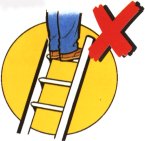
|
The overall length of a
ladder is not the same as its usable length - allow
one metre of ladder length above the highest rung you
use. Never stand on the top three rungs. Make sure
the ladder is at a safe angle (see below). |
Is the ladder strong enough?
|
Ladders are rated according
to their safe working load. Do you need a ladder for
domestic use, or a more heavy-duty one for trade or
industrial purposes? If you need to move around a lot
at height or carry lots of materials, a platform (e.g.
the Pro-deck) or a mobile tower may be more
appropriate. |
Is it safe enough?
|
Make sure there are no
cracks, no loose/bent/missing rungs, no bent stiles
(the outside uprights of a ladder), no warping or
splitting wood, no corrosion (metal), no sharp edges.
Are the footpads, caps and other rubber fittings
OK?
Ladders should never be painted - this could hide
dangerous defects from view. Wooden ladders can be
protected with clear varnish or transparent rot-proofer.
|
Putting up a short ladder
|
|
Whenever carrying a ladder, keep the
front end above head height. Turn carefully! |
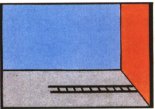 |
1 Place the base against a
solid surface |
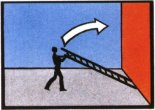 |
2 Lift the top of the
ladder and 'walk down' it, rung by rung and hand by
hand, moving in towards the base until the ladder is
upright. |
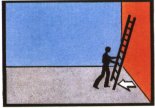 |
3 Rest the top of the
ladder against the wall or other first surface, then
lift or slide the base out to its final
position. |
Ladders are
designed so that their safest angle of use comes when
every 1 measure out from the wall is matched by 4
measures up.
|
Putting up a long ladder
(2 or more people needed)
|
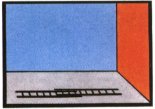 |
1 Lay the ladder on the
ground with the base at the spot where it is to
stand. |
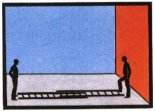 |
2 Heaviest person: stand at
the base and put a foot on the bottom rung. |
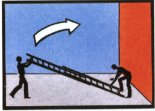 |
3 Remaining person(s):
start to raise the ladder while heavy partner reaches
forward from the base and grasps the stiles (take care
not to pull or strain while a back is arched, as this
can cause serious injury). |
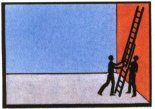
|
4 Once ladder is upright,
ease the top to rest against the wall or other firm
surface. |
Putting up an extension ladder -
push-up type
|
| A short
extension (under 2 metres) can be done after the
ladder has been raised. For an extension of over 2
metres: lay it on the ground in the position to be
used, then extend it to the required length. Then
raise the ladder as for a long ladder, described
above.
Always extend the ladder before climbing it. |
| Work the safe
way |
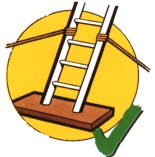 |
Place the ladder base on a
firm, level, dry surface. If this is not possible,
e.g. working on grass, tie the feet of the ladder to
stakes in the ground to stop it slipping, and place a
large wooden board underneath to help prevent it
sinking.
Don't put a ladder on top of boxes, bricks, barrels or
any other unstable surface just to gain extra
height. |
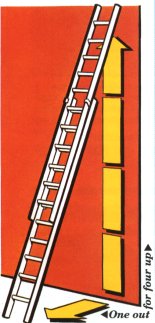 |
Position the ladder so that
the base won't slip outwards. Ladders are designed so
that their safest angle of use comes when every 1
measure out from the wall is matched by 4 measures
up. |
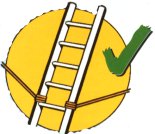 |
Secure the bottom and the
upper part of the ladder by tying them (from stiles,
not rungs) with rope or straps onto a stable, fixed
object. You can tie the base to stakes in the ground,
or use fixed blocks or sandbags to help guard against
the ladder slipping, or buy special stabilisers. A
rope or strap tied from a stile onto a fixed object at
about the height of the fifth rung from the bottom
will help to stop any further movement. If it's
impossible for some reason to secure the ladder, get
another adult to 'foot' it (by standing with one foot
on the bottom rung and holding a stile in each
hand. |
|
Rest the top of the ladder
against a solid surface, never against guttering, or
other narrow or plastic features. Where a surface is
too brittle or weak to support the top of the ladder,
use a stay or a stand-off resting on a firm surface
nearby. Bolt or clip this to the top of the ladder
before putting up the ladder. |
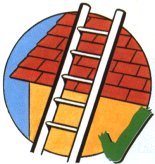 |
Have at least three rungs
extending beyond the roof's edge if you're using a
ladder to get yourself up onto the roof. |
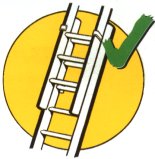 |
Make sure that longer
extension ladders (over 18 rungs) have an overlap of
at least three rungs. Shorter ones need a minimum
overlap of two rungs. |
More ladder safety advice
Keep your body facing the ladder at al times,
centred between the stiles.
Don't reach too far forwards or sideways , or stand
with one foot on the ladder and the other on something
else.
Move the ladder to avoid overstretching, and
re-secure it whenever necessary.
Try to keep both hands free to hold the ladder as
much as possible when climbing or descending - use a
shoulder bag, belt holster or belt hooks.
Don't carry heavy items or long lengths of material
up a ladder.
Hold onto the ladder with one hand while you work.
You can get special trays which fit between the stiles
to take paint pots, tools etc.
Wear strong, flat shoes or boots, with dry soles
and a good grip. Don't wear sandals, slip-ons or have
bare feet on a ladder.
Make sure the door is locked, blocked or guarded by
someone if you're up a ladder in front of it.
Don't use a ladder in a strong wind.
Don't use a ladder near any power lines.
Don't allow any child under 16 to use a
ladder.
|
Storing Ladders
|
Always store
ladders in a covered, ventilated area, protected from
the weather and away from too much dampness or
heat.
Ladders can fall if stored vertically, so take
particular care. If possible, secure the top with a
bracket.
Never hang a ladder from a rung.
Don't store a ladder in any place a child might be
tempted to climb it.
For storing horizontally, a rack or wall brackets are
ideal (hang from a stile). Keep wooden ladders clear
of the ground to avoid contact with damp.
|
Ladder security
|
|
For security reasons, as well as
good maintenance, don't store a ladder on view
outdoors where it could be stolen or used in a break
in. If it has to be stored in view make sure that
it is secured to an immovable object. |












